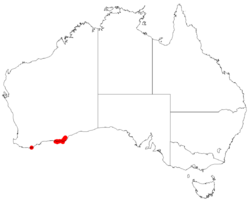Biology:Leucopogon apiculatus
| Leucopogon apiculatus | |
|---|---|
| Scientific classification | |
| Kingdom: | Plantae |
| Clade: | Tracheophytes |
| Clade: | Angiosperms |
| Clade: | Eudicots |
| Clade: | Asterids |
| Order: | Ericales |
| Family: | Ericaceae |
| Genus: | Leucopogon |
| Species: | L. apiculatus
|
| Binomial name | |
| Leucopogon apiculatus R.Br.[1]
| |

| |
| Occurrence data from AVH | |
Leucopogon apiculatus is a species of flowering plant in the family Ericaceae and is endemic to the south of Western Australia. It is an erect shrub with oblong to elliptic leaves and pink to white tube-shaped flowers.
Description
Leucopogon apiculatus is an erect, openly-branched shrub that typically grows to a height of 0.3–2 m (1 ft 0 in–6 ft 7 in) and has oblong to elliptic leaves 13–19 mm (0.51–0.75 in) long with a sharply-pointed tip. The sepals are about 5.2 mm (0.20 in) long with narrowly lance-shaped bracts at the base, the petals white to pink, the petal tube and the petal lobes about the same length as the sepals. Flowering occurs from July to November.[2][3]
Taxonomy
Leucopogon apiculatus was first formally described in 1810 by Robert Brown in Prodromus Florae Novae Hollandiae et Insulae Van Diemen.[4][5] The specific epithet (apiculatus) means "abruptly ending in a small point", referring to the leaves.[6]
Distribution and habitat
This leucopogon grows in sandy or stony soils on granite outcrops, hills and rocky slopes in near-coastal areas of southern Western Australia, from Cape Le Grand National Park in the west to Cape Arid National Park in the east, including on the islands of the Recherche Archipelago, in the Esperance Plains and Mallee bioregions of southern Western Australia.[2][7]
Conservation status
Leucopogon apiculatus is listed as "Priority Three" by the Government of Western Australia Department of Biodiversity, Conservation and Attractions,[2] meaning that it is poorly known and known from only a few locations but is not under imminent threat.[8]
References
- ↑ "Leucopogon apiculatus". Australian Plant Census. https://biodiversity.org.au/nsl/services/apc-format/display/106790.
- ↑ 2.0 2.1 2.2 "Leucopogon apiculatus". FloraBase. Western Australian Government Department of Parks and Wildlife. https://florabase.dpaw.wa.gov.au/browse/profile/6357.
- ↑ Bentham, George; von Mueller, Ferdinand (1868). Flora Australiensis. 4. London: Lovell Reeve & Co.. p. 201. https://www.biodiversitylibrary.org/page/11266422#page/210/mode/1up. Retrieved 24 June 2022.
- ↑ "Leucopogon apiculatus". APNI. https://id.biodiversity.org.au/instance/apni/536928.
- ↑ Brown, Robert (1810). Prodromus Florae Novae Hollandiae et Insulae Van Diemen. London. p. 542. https://www.biodiversitylibrary.org/item/21871#page/410/mode/1up. Retrieved 26 June 2022.
- ↑ Sharr, Francis Aubi; George, Alex (2019). Western Australian Plant Names and Their Meanings (3rd ed.). Kardinya, WA: Four Gables Press. p. 135. ISBN 9780958034180.
- ↑ Hislop, Michael; Chapman, Alex R. (2007). "Three new and geographically restricted species of Leucopogon (Ericaceae: Styphelioideae: Styphelieae) from south-west Western Australia". Nuytsia 17: 173–174. https://florabase.dpaw.wa.gov.au/science/nuytsia/480.pdf. Retrieved 24 June 2022.
- ↑ "Conservation codes for Western Australian Flora and Fauna". Government of Western Australia Department of Parks and Wildlife. https://www.dpaw.wa.gov.au/images/documents/plants-animals/threatened-species/Listings/Conservation%20code%20definitions.pdf. Retrieved 24 June 2022.
Wikidata ☰ Q17243488 entry
 |


